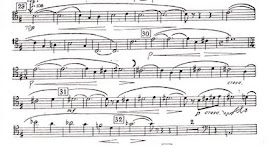An Example
Recently we played a concert at Blossom that featured Beethoven 3rd Piano Concerto and Shostakovich Symphony #10.
The Beethoven contains a beautiful duet with the flute in the second movement. For this I chose a reed that had a clear, warm tone and great smoothness and steadiness of pitch in the tenor range.
The Shostakovich contains two solo sections in the first and 4th movement. For these solos you need a reed that has a big dynamic range, is capable of lots of color contrast and has a good "p". My Beethoven reed had a beautful, clear sound, but wasn't dramatic enough for these solos, so I went with something else.
The solo in the fast section of the last movement features mainly low staccato notes. Neither the Beethoven nor the reed for the other Shostakovich had great low note articulation, but I found another one in my box that did.
My Selection Process
OK, so you're probably wondering how does he actually identify reeds with particular characteristics and how does he enhance those characteristics so they can be used for the most demanding repertoire!
Given the same shape, gouge and same preliminary scrape some reeds exhibit have unusual strengths in one area or another. For instance, though of the same thickness, some reeds will respond better than others. These may be good for particularly soft passages like those in Brahms 4th, 2nd mvt.
Other reeds may exhibit an ease of response in the low register and good pitch in that range. These may be useful for the opening of Tchaikovsky 6th, for instance.
Others may have an extremely vibrant, rich tone. Good for Shostakovich 9th?
For instance, though of the same thickness, some reeds will respond better than others. These may be good for particularly soft passages like those in Brahms 4th, 2nd mvt.
Tests
I test these reeds (as I do all reeds) by playing long tones, making a mental note of the reed's characteristics. I also try playing scales at full volume to check for resonance and evenness throughout the range. Then I'll try playing the scale in a subtone to check for ease of response and smoothness at "pp". Then I'll test the reed by playing something challenging that I'm performing in the coming weeks to see how it does.
Enhancing Good Qualities
Next I finish the reed with the specific goal of performance of a particular piece in mind. I usually do this just before or during the first rehearsal for that piece. The reed is finished in most ways, to within a couple thousands of an inch thickness along the spine. My profiler leaves much more cane on in the rails and channels. Though I must remove a lot of cane in these areas when finishing the reed, I believe this allows me more leeway in customizing the reed, enhancing its strengths, de-emphasizing its weaknesses.
Next I use my knowledge of the various parameters of the reed's construction and scrape to nudge the reed in the right direction. For a comprehensive list of these areas for adjustment please see my website.
For instance, if I want to further enhance a reed's low register I might trim the area near the collar thinner, ream it deeper than usual, removing cane from under the first wire and/or make the second wire more oval.
Remember that you need a large number of reeds to choose from in order to do this sort of customization as few reeds will exhibit exactly the right qualities you are looking for.
Also remember that it's OK if a specialty reed doesn't perform certain tasks acceptably. The reed that is best for the opening of Tchaikovsky's 6th Symphony doesn't need to have a stable E in the staff, for instance!
In my next post, I'll discuss how I rotate reeds in rehearsal and performance.





No comments:
Post a Comment